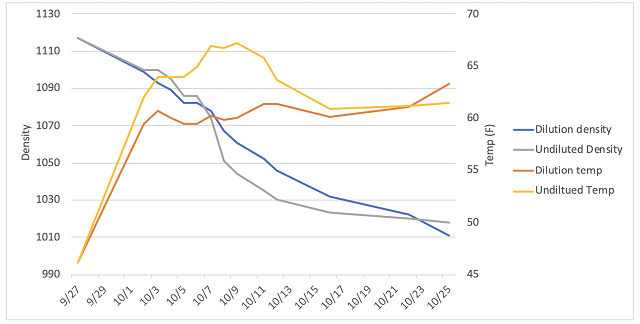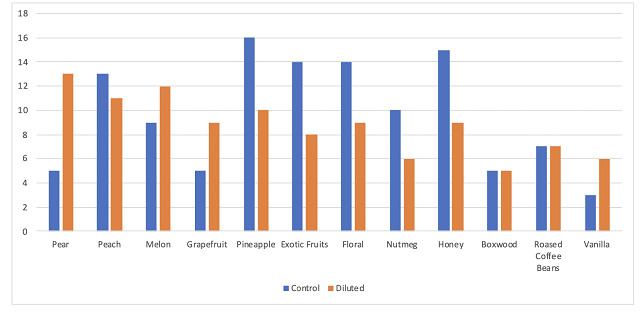Effect of Juice Dilution in Petit Manseng
Emily Pelton
Veritas Vineyards and Winery
Summary
Petit Manseng plantings in Virginia are increasing due to its growing and ripening characteristics during humid summers, however, this variety often reaches high levels of sugar while retaining very high levels of acidity, making completion of fermentation a challenge. One approach to ensuring completion of fermentation is watering back juice to reduce both acid and potential alcohol, but may lead to dilution of flavor and aroma. In this experiment, Petit Manseng juice was diluted by 10%, decreasing the sugar from 27.1° Brix to 23.7° Brix. The diluted juice completed fermentation with low volatile acidity (0.17 g/L) while the fermentation of the undiluted juice stuck with over 5% residual sugar and high volatile acidity (0.72 g/L). Dilution of sugar also led to dilution of some tropical flavors. Dilution led to lower perception of Petit Manseng specific descriptors in blind sensory analysis. Watering back may not be appropriate for varietal Petit Manseng wine, but may be a useful approach when the wine will be blended.
Introduction
Petit Manseng can be made as a varietal wine, but it is also useful as a blending tool. The high alcohol of this wine brings palate volume and its high acidity helps lower acid varieties such as Viognier gain freshness. The intense aromatics of Petit Manseng can add floral and fruit to components in small amounts. However, with the challenges of completing fermentation, Petit Manseng can also bring unwanted residual sugar to the blend. The high alcohol and high acidity in Petit Manseng fermentations are thought to create a stressful environment for yeast that prevents completion of fermentation. Watering back to reduce potential alcohol is one potential solution.
When watering back, a few things to consider:
- Water addition is allowable for the correction of sugar concentration as well as to solubilize or facilitate other additions1.
- When doing water addition, realize that everything is diluted (acids, flavor compounds), not just sugar2, while volume is increased (make sure your tank is big enough).
- If acid correction is desired (maybe not the case in Petit Manseng), add tartaric acid or a tartaric: malic blend to the water to be used for addition at a rate close to the target TA of the wine (ex: 4-6 g/L)2,3.
- In red wines, make sure you are calculating your addition based on the final volume of the wine, not the volume of the must2.
- Don’t do a 100% addition up front. It is better to do a 65-70% addition initially and measure potential alcohol based on RS after fermentation has progressed about halfway. Above 25°Bx, potential alcohol conversion rates are less accurate3.
The purpose of this demonstration was to use watering back to mitigate the strong acidity and alcohol levels of Petite Manseng and encourage the completion of fermentation.
Methods
Grapes were harvested and refrigerated overnight. The following day, grapes were destemmed and crushed to TBins with the addition of 40 ppm SO2, held overnight in a refrigerated trailer, then pressed to tank the following day. Juice was cold settled overnight then racked to fermentation vessels. The control was racked to two neutral oak barrels. The diluted juice was fermented in a stainless steel tank.
Brix measurements were taken on settled juice. The juice in the tank was left at 27.1°Brix while the juice in the barrel was watered back to 23.7°Brix using water acidulated to pH of 3.56 using tartaric acid. This included a total addition of 220L water to a tank of 1767 L juice.
Each treatment was inoculated with 25 g/hL ICV D47 (Scottlabs, Lallemand) rehydrated in 6 g/hL Fermoplus Energy Glu (AEB) and received 30 g/hL Actimax Naturae (Agrovin) at ⅓ brix depletion. Fermentation was monitored daily. After completion of fermentation, 45ppm SO2 was added and wine was racked to neutral barrels for storage.
Sensory analysis was completed by a panel of 25 wine producers. Wines were presented blind in randomly numbered glasses. Tasters were presented with both wines and asked to score each wine for the presence/absence of 12 descriptive terms found in the literature to describe Petit Manseng. Tasting order was balanced between groups. They were also given open ended questions to describe the wines.
Results
Watering back resulted in a difference of 3.4°Bx and decrease in TA of 0.8 g/L. Fermentation kinetics show a steady fermentation for the dilution. The fermentation of undiluted juice sped up considerably at a density of 1080 (19.4°Bx), with a spike in temperature to 68°F. At 1030 (7°Bx), however, fermentation slowed noticeably, plateaus, and never finishes. Fermentation curves of this shape could be caused by a number of factors including poor alcohol tolerance, elevated temperature, low cell number due to limited nitrogen availability or lack of early oxygen. The thermal tolerance of D47 is 59-68°F. It is possible that the cumulative osmotic stress of growing alcohol and remaining sugar coupled with temperature near the maximum tolerance of the yeast led to decrease in yeast metabolism and loss of cell viability.
The wine from the undiluted juice has high volatile acidity and high residual sugar (Table 2), a difficult wine to blend. By contrast, the diluted wine finished fermentation with low volatile acidity. It appears the diluted wine also underwent partial malolactic fermentation (Table 2). In blind sensory analysis, fewer people perceived pineapple, exotic fruits, floral, nutmeg and honey in the wine from diluted juice while scores for pear, grapefruit and vanilla increased in the diluted wine (Figure 2). Open ended comments indicated that both the residual sugar and acetic acid in the control wine were perceptible, but that this wine was also perceived as more concentrated in aromas.
Table 1: Juice chemistry before and after dilution (in-house data)

Figure 1: Fermentation kinetics for Undiluted and Diluted Petit Manseng

Table 2: Finished wine chemistry for undiluted and diluted Petit Manseng (ICV labs)

Figure 2: Presence or absence scores for 12 Petit Manseng descriptors

